HaloSat. Credit: University of Iowa
Space research is an expensive business. Once a space-based instrument is proposed, researchers want to get as much value as possible from it. The proposed satellite quickly grows in instruments and capabilities. Expensive, radiation-hardened components must be used. The expense places satellite instrument platforms out of reach of most research budgets.
Enter the CubeSat, the flat-pack furniture of the space industry. Cheap and accessible CubeSats have democratized space science. They can be as small as a 10-cm cube and can weigh less than a kilogram. Being small and light, they cannot contain much instrumentation, so the costs stay low. And, because they are placed in low-Earth orbit, they have relatively short lifetimes, so radiation-hardened electronics are not needed.
A cheap and cheerful X-ray observatory
LaRocca and colleagues, reporting in SPIE's Journal of Astronomical Telescopes, Instruments, and Systems, have detailed the development of a CubeSat called HaloSat, designed to measure oxygen's X-ray emission from diffuse sources, like the halo around the Milky Way. The satellite doesn't image, but it does count X-rays from a specific direction and from a chosen energy band, with some spatial resolution.
To achieve that, the researchers used silicon drift detectors, the output of which is amplified and sent to a signal processing board. The onboard electronics are able to quickly store X-ray energy and counts from the three detectors. The detectors themselves have no optics, which is a problem because the researchers need to be sure that the X-rays come from the targeted source. To solve this problem, the detectors were set rather deep inside the satellite with a collimating tube leading to the outside world. Coarse maps of X-ray emissions are then built up by scanning the satellite's orientation over the target.
The entire scientific instrument weighs in at less than 3 kg and consumes about 4 W. The control system brings the package up to 12 kg, while the entire satellite is about the size of a thick book.
HaloSat was launched in 2018, and its mission has been extended until mid-2020. So far, it has mapped X-ray emissions from the Milky Way and the Crab Nebula. The simple mapping spectrometer has delivered remarkably clean data, which will enable a few years of analysis and insights.
The HaloSat science payload is completely contained in a single aluminum subassembly. This subassembly is mounted inside the payload enclosure of the spacecraft bus. Credit: University of Iowa
Live fast, die young
HaloSat will deorbit before the end of 2020 due to drag, so the mission cannot be extended much longer. Such temporal limitation is part of the life of a CubeSat-they are the mayfly of spacecraft. The question is not if the satellite will live longer, but if useful scientific results can be gained from such a short mission. The researchers have proven the affirmative: low-cost, short-lived satellite missions can deliver useful results.
Another aspect of the CubeSat is the development timeline. The money for HaloSat arrived in 2016. The instrument was completed, integrated with the rest of the satellite and launched by mid 2018. This is incredibly quick. To put the development time in perspective, the conceptual work for the GRACE-FO mission (gravity recovery and climate experiment), which is an improved copy of the original GRACE mission, began in 2012, and finally launched in 2018.
This research also demonstrates the limitations of CubeSats. HaloSat, like all CubeSats, can do one thing and only for a relatively short time. If the researchers have results that they would like to follow up, then they are unlikely to be able to do that with the same satellite. If the data show that a different type of instrument is required, the researchers will have to wait until a new satellite is launched. This highlights that, although CubeSats are making space more accessible, researchers need to have a very well-planned and focused mission in order to make a success of it. HaloSat demonstrates just how to do that.
As the authors put it, "The rapid development, integration, and launch schedule of 2.5 years for CubeSats is sure to garner more interest in the field of astrophysics as both a test bed for new technology as well as a platform for focused missions. HaloSat may be one of the first astrophysics CubeSats, but it will not be the last."
More information: Daniel M. LaRocca et al. Design and construction of the x-ray instrumentation onboard the HaloSat CubeSat, Journal of Astronomical Telescopes, Instruments, and Systems (2020). DOI: 10.1117/1.JATIS.6.1.014003
Provided by SPIE
























